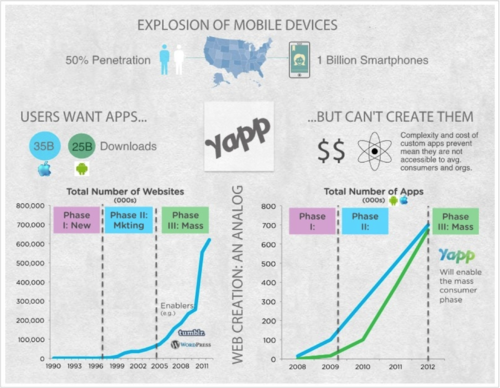This is a post by our CEO, Maria Seidman, based on a burst talk she gave at xconomy mobile in NY
I am not a technologist. English was more my thing in college so that is why I’ll start with a quote from the playwright George Bernard Shaw who said that “life is not about finding but life is about creating.”
I thought I’d take my five minutes to talk to you about creating and the future of the app creation economy.
Today, there are ~ 700,000 apps on each of the iOS and Google Play app stores. The majority of these were custom developed. According to Vision Mobile, the average cost of development of an iOS app is $27k and for Android it is $23k. This cost is only going up – fragmentation is getting worse (there were 4,000 device/OS combinations for Android alone) and design and maintenance (currently at 25% and 10%) will continue to grow.
That is why Cross Platform Development (CPD) tools like Phonegap, Appcelerator, Unity and hundreds of others have fiercely multiplied over the past few years. These cross platform tools take HTML5 and wrap it in mobile specific native functionality. This enables developers who don’t know how to code for iOS and Android to rapidly deploy apps across multiple platforms. Phonegap alone accounts for 4% of the apps on the app store and my estimation is that ~10% of the apps in the store use one of these CPD tools.
These dynamics will continue to play out, but they only point to a continued growth at the current pace of apps (the number of apps grew 40% last year). I would argue, however, that we are about to hit a hockey stick in the number of apps created. This thesis is at odds with many industry commentators who believe that apps are temporary and compare them to AOL vs. the open web.
Speaking of the web, let’s take websites as an analog. There are ~ 620M domains online today. Yet 60% of those came online in the last 2 years alone. While the web is thought of as a ’90s phenomenon, the reality is the hockey stick is now.
At the beginning, the web was a one to very many medium. One website (e.g. AOL) reached millions. Then came the marketing phase where companies and brands went out and hired Razorfish or Sapient and spend millions to create a website. The modern web (web 2.0 and up), however, is where the explosion really happened. I would argue that this was because the web went from a one to many communication, to personalized (Facebook), customized (iGoogle, MySpace, Tumblr, etc.) and created (WordPress).
Back to apps. In 2008, it was really big brands and garage developers that started on the platform. It was a one to (not yet so) many platform if you think about the early apps. Quickly every brand felt they needed to be on the platform with marketing or brand extension apps. Today, any successful app is by definition personalized. It’s not about the weather – it’s about the weather where you are standing right now. It’s not about news, it’s about your Twitter feed, curated news. Some apps have also introduced customization – Instagram isn’t about photos – it’s about customizing your photos with a filter. What about creation?
As the concept of “democratization” moves down the long tail – app creation for developers (CPD tools), for companies, for SMBs, and now (with Yapp) for consumers – we will begin to see the the real dawn of app creation as we enter the next phase of the app creation economy and a movement along the personalization, customization, and creation continuum.
With hundreds of millions of apps, finding them will be the next big challenge.


